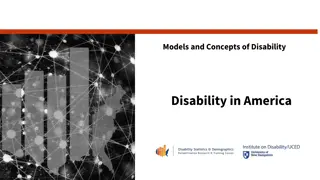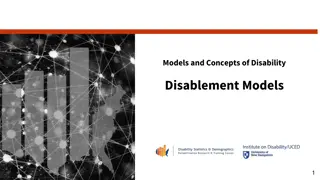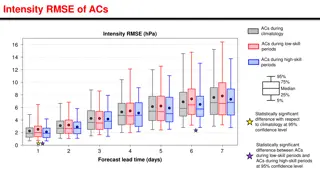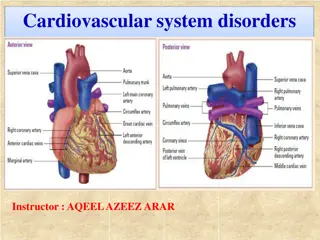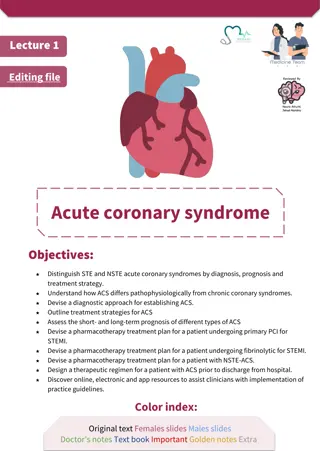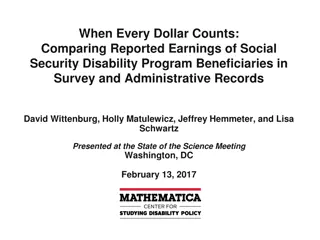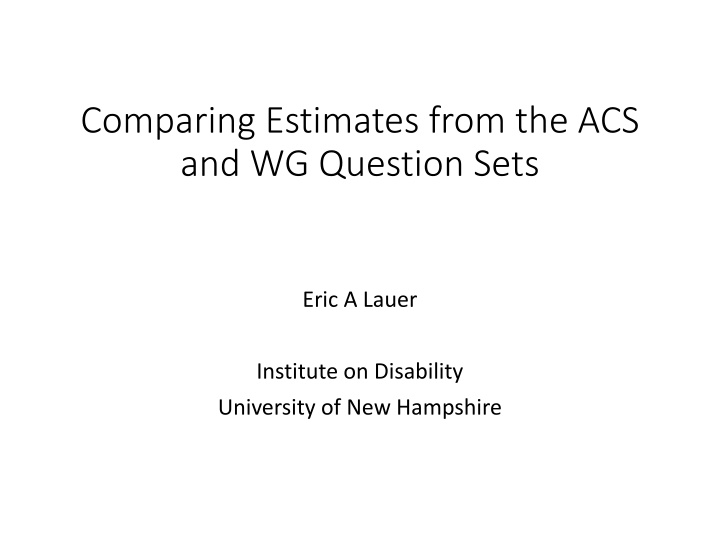
Comparing Disability Question Sets: ACS vs. WGSS Estimates
National surveys are evaluating the inclusion of standardized disability identifiers using question sets such as the Washington Group Short Set (WGSS) and the American Community Survey (ACS). Limited research exists to compare these questions in disability research, examining prevalence, demographic factors, and disability types among populations.
Download Presentation

Please find below an Image/Link to download the presentation.
The content on the website is provided AS IS for your information and personal use only. It may not be sold, licensed, or shared on other websites without obtaining consent from the author. If you encounter any issues during the download, it is possible that the publisher has removed the file from their server.
You are allowed to download the files provided on this website for personal or commercial use, subject to the condition that they are used lawfully. All files are the property of their respective owners.
The content on the website is provided AS IS for your information and personal use only. It may not be sold, licensed, or shared on other websites without obtaining consent from the author.
E N D
Presentation Transcript
Comparing Estimates from the ACS and WG Question Sets Eric A Lauer Institute on Disability University of New Hampshire
Background National surveys are considering changes to the annual inclusion of standardized disability identifiers These question sets include the Washington Group Short Set (WGSS) and American Community Survey (ACS) identifiers There has been limited research to understand and compare these questions in disability research.
ACS & WG Question Topics Hearing Deaf or difficulty hearing (even with hearing aids)? Vision Blind or difficulty seeing (even when wearing glasses)? Cognition Difficulty remembering, concentrating, or making decisions? Ambulation Difficulty walking or climbing stairs? Self-care Difficulty bathing or dressing?
Development Goals Question sets developed with goals that include: Policy relevance Lengths appropriate for censuses Comparable across populations Development narratives recognize: General disability measurement Not comprehensive disability assessment Not identifying true disabled population (if one exists) Limited by data collection processes
Methods 2010-2015 National Health Interview Survey data ACS responses (yes) versus Washington Group responses (a lot of difficulty and cannot do) Prevalence and 95% confidence intervals were estimated Exploratory Null Hypotheses: Disability type prevalence would be consistent for people reporting disabilities Demographic and social factors would be consistent for people reporting disabilities Disability prevalence by type and for multiple disabilities
Percentage of people with Disabilities by Question Type and Set
Percentage of Disability Types among People with Any Disability
Percentages of Disability Types among People with Multiple Disabilities
Percentages of Social Factors among People with Multiple Disabilities
Discussion Prevalence estimates vary significantly WG coding (a lot of difficulty or cannot do) Demographic distributions consistent between question sets Multiple disability estimates consistent from ACS and WGSS ACS and WGSS questions can be used to study similar hypotheses Multivariate analyses recommended
Thank You Eric A. Lauer, MPH, PhD Project Director Institute on Disability University of New Hampshire Durham, NH 03824 eric.lauer@unh.edu


